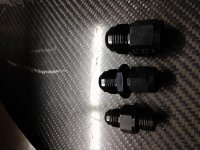RacinDuallie
Black Sheep Racing
- Joined
- Apr 24, 2006
- Messages
- 17,382
I'm in this debate with the owner of local speed shop that I support.
Picked up bunch of AN fittings to hook up trans fluid cooler.
He questioned why I was jumping the size up to -10AN.
Then proceeded to tell me I'm wasting my time and asked why?
Told him bigger so it has more time in cooler to cool.
Said I am an idiot, that hydraulic pressure is hydraulic pressure. Said everything I'm doing by stepping up to -10 inlet/outlet plus -10 cooler, is waste.
Let's hear it from the more smarter peeps than me.
 op:
op:
Picked up bunch of AN fittings to hook up trans fluid cooler.
He questioned why I was jumping the size up to -10AN.
Then proceeded to tell me I'm wasting my time and asked why?
Told him bigger so it has more time in cooler to cool.
Said I am an idiot, that hydraulic pressure is hydraulic pressure. Said everything I'm doing by stepping up to -10 inlet/outlet plus -10 cooler, is waste.
Let's hear it from the more smarter peeps than me.

